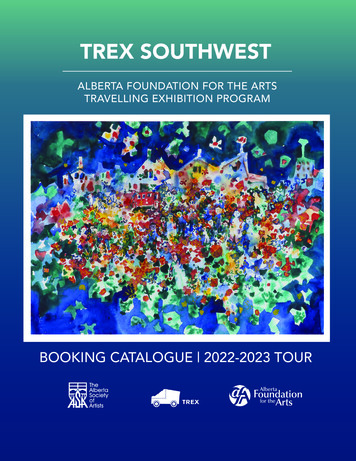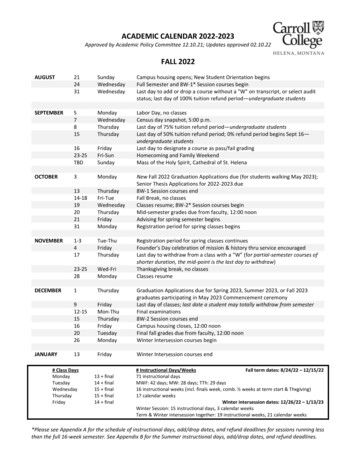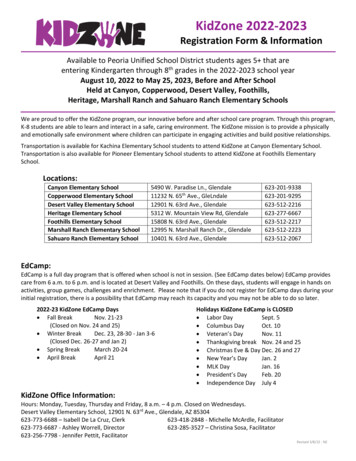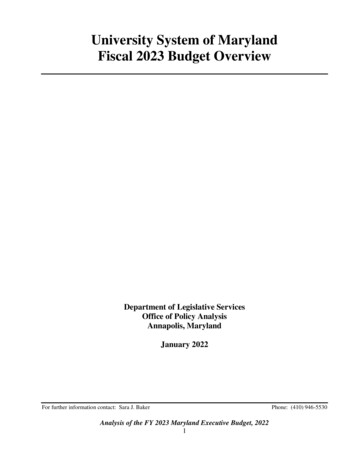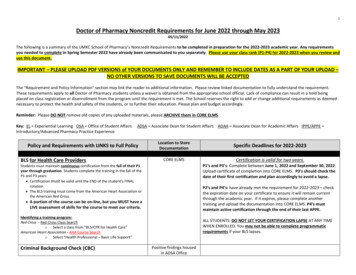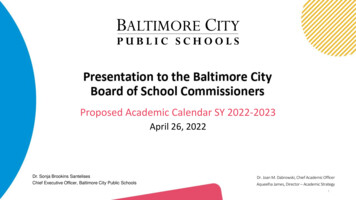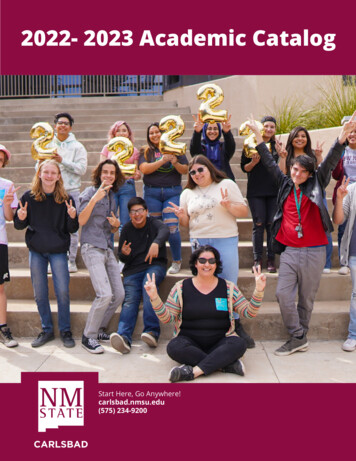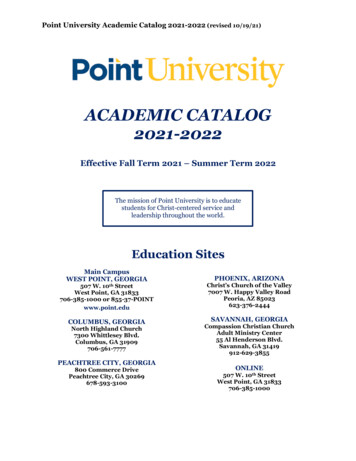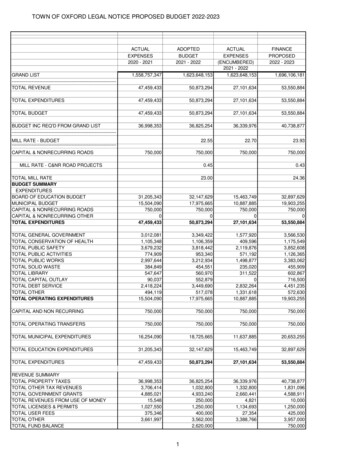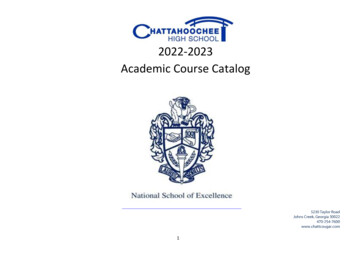
Transcription
2022-2023Academic Course Catalog1
Table of Contents:Fine Arts- 4Career, Technical and Agricultural EducationAutomobile Maintenance and Light Repair- 5Computer Science- 6Engineering Technology- 6Fashion, Merchandising and Retail Management- 7Graphic Design- 8Marketing and Management- 9Therapeutic Services/Allied Health and Medicine- 10Therapeutic Services/Sports Medicine- 11Animation and Digital Media- 12English- 13-14Math- 15-16Non-Departmental- 17Performing Arts- 17-20Physical Education- 21Science- 22-23Social Studies- 23-24Talented and Gifted (TAG)- 24-25World Language- 25-262
Fine ArtsCourse TitleIntro to ArtCourse ital Design Projects50.0725001S9-12Intro to ArtCeramics 150.0411001S9-12Intro to ArtCeramics 250.0412001S10-12Ceramics 1Ceramics 350.0413001S10-12Ceramics 2Ceramics 450.0414001S11-12Ceramics 3Draw/Painting 150.0314001S9-12Intro to ArtDraw/Painting 250.0314001S9-12Draw/Painting 1Photography 150.0711001S9-12Intro to ArtPhotography 250.0712001S10-12Photography 1Major TopicsIntroduction to Art is an entry-level class that establishes a standard and consistent foundation in thediscipline of visual art. Students will be introduced to all aspects of visual art including but not limited toart as personal communication, drawing, sculpture, ceramics, design, aesthetics, careers, art criticismand art history.This course will introduce the use of computers as a medium of the production of original artwork andfor communication of ideas through print and multimedia presentations. Methods and vocabulary ofelectronic drawing painting and photography imaging will be taught utilizing programs such as Adobe.The ability to create good compositions using these programs using digital media translates intosecuring the careers of tomorrow.Ceramics 1 is an introductory course in ceramics covering the three basic methods of hand building.Students will produce ceramic artwork using pinch, slab, and coil techniques. Students will learn thebasic vocabulary of ceramics as well as methods of surface treatment, firing, and other related aspects.Ceramic history, aesthetics, and art criticism will be incorporated throughout the course.Ceramics 2 provides in-depth work with clay beyond that of Ceramics 1. Students will further technicalability in hand building, surface decoration, and/or wheel-thrown ceramics. Glaze chemistry will beaddressed with an emphasis on how a glaze works and how to alter results. Alternative firing techniqueswill introduce students to various surface effects and firing atmospheres. Students will work in a moreconceptual manner to develop their own ideas, style and artistic voice. Students will continue toinvestigate ceramics from around the world and throughout time.Ceramics 3 is an advanced course providing in-depth work with clay. Students will further technicalability in hand building, surface decoration, and/or wheel-thrown ceramics. Glaze chemistry will beaddressed with an emphasis on how a glaze works and how to alter results. Alternative firing techniqueswill introduce students to various surface effects and firing atmospheres. Students will work in a moreconceptual manner to develop their own ideas, style and artistic voice while developing a portfolio.Ceramics 4 provides in-depth work with clay. Students will work in a more conceptual manner todevelop their own ideas, style and artistic voice while developing a portfolio.Drawing & Painting 1 instructs students in fundamental drawing skills and prepares them to make thetransition to painting. Course work builds on drawing skills introduced in Introduction to Art. Drawingapproaches include contour, value to model form, gesture, perspective and color; students work withdrawing media such as pencil, charcoal, conte, oil pastels. Art history, criticism and aesthetics areincorporated with studio production of drawings and paintings.Drawing and Painting 2 develops fundamental painting skills and continues to strengthen compositionand drawing skills. The course includes studies in color sensitivity and a wide range of media andtechniques. Art history, criticism, and aesthetics are incorporated with studio production of drawingsand paintings.Photography 1 is an introduction to black and white photography and darkroom processing. Studentswill construct their own pinhole camera and create a photographic portfolio as they learn the technicaland artistic aspects of photography. A brief introduction to digital photography will be included. Photohistory, critiques of phots, aesthetics and design will be addressed throughout the semesterPhotography 2 builds on basic skills and darkroom techniques learned in Photography 1. Students honeskills in communicating meaning through photography. They learn to us a 35 mm camera, develop andprint images from black and white film and refine darkroom and printing techniques. The courseincorporates aesthetics, art criticism, art history and a brief introduction to digital photography.3
Photography 350.0713001S10-12Photography 2Photography 450.0714001S11-12Photography 3Sculpture 150.0611001S9-12Intro to ArtSculpture 250.0612001S10-12Sculpture 1Sculpture 350.0613001S10-12Sculpture 2Sculpture 450.0614001S11-12Sculpture 3AP Drawing erRecommendationPhotography 3 and 4 hone skills in communicating meaning through photography. Students will work ina more conceptual manner to develop their own ideas, style and artistic voice while developing aportfolio.Photography 3 and 4 hone skills in communicating meaning through photography. Students will work ina more conceptual manner to develop their own ideas, style and artistic voice while developing aportfolio.Sculpture 1 introduces students to the production of three-dimensional art making including additive,subtractive and modeling processes of sculptural construction. Sculpture’s influence on theenvironment will be examined, as well as the investigation of a variety of media. Students are expectedto make connections as they explore meaning, develop creative thinking skills, search for contextualunderstanding resulting in authentic assessment and reflection.Sculpture 2 offers in-depth study to the production of three-dimensional art making including additive,subtractive, casting and modeling processes while investigating a variety of media. Students are expecteto make connections as they explore meaning, develop creative thinking skills, search for contextualunderstanding resulting in authentic assessment and reflection.Sculpture 3 and 4 offers in-depth study of the production of three-dimensional art making includingadditive, subtractive, casting and modeling processes while investigating a variety of media. Studentswill work in a more conceptual manner to develop their own ideas, style and artistic voice whiledeveloping a portfolio.Sculpture 3 and 4 offers in-depth study of the production of three-dimensional art making includingadditive, subtractive, casting and modeling processes while investigating a variety of media. Studentswill work in a more conceptual manner to develop their own ideas, style and artistic voice whiledeveloping a portfolio.College Board AP Course DescriptionsAP level content culminating in AP portfolio submission and/or AP examY11-12TeacherRecommendationCollege Board AP Course DescriptionsAP level content culminating in AP portfolio submission and/or AP examY11-12TeacherRecommendationCollege Board AP Course DescriptionsAP level content culminating in AP portfolio submission and/or AP examY10-12TeacherRecommendationCollege Board AP Course DescriptionsExplore the history of art across the globe from prehistory to the present. You’ll analyze works of artthrough observation, discussion, reading, and research.AP 2D DesignAP 3D DesignAP Art HistoryReturn to Table of Contents4
Career, Technical & Agricultural Education (CTAE)Automobile Maintenance and Light Repair PathwayCourse TitleCourse #TermGrade(s)Prerequisite(s)Major TopicsBasic Maintenance and LightRepair47.531100147.5311002Y9-12NoneThis course is designed as the foundational course for the Automobile Maintenance and Light RepairPathway. Students in this course will learn the basic skills needed to gain employment as a maintenanceand light repair technician. Students will be exposed to courses in automotive preventative maintenanceand servicing and replacing brakes and steering and suspension components. In addition, students willlearn how to do general electrical system diagnosis, learn electrical theory, perform basic tests anddetermine necessary action. In addition, students will learn how to evacuate and recharge airconditioning systems using the proper refrigerant. The hours completed in this course are aligned withASE/NATEF standards and are a base for the entry-level technician. The pre-requisite for this course isadvisor approval.Maintenance and Light Repair 247.53210014705321002Y10-12Basic Maintenanceand Light RepairStudents will learn the basic skills needed to gain employment as a maintenance and light repairtechnician and will expose students to automotive preventative maintenance and servicing, as well asreplacing brakes, and steering and suspension components. Students will also learn general electricalsystem diagnosis, electrical theory, basic test requirements, and determining necessary action. Inaddition, students will learn how to evacuate and recharge air-conditioning systems using the properrefrigerant. Standards for this course are aligned with the ASE/NATEF standards and are an excellentfoundation for the entry-level technician.Maintenance and Light Repair 347.533100147.5331002Y11-12Maintenance and LightRepair 2Students will learn the basic skills needed to gain employment as a maintenance and light repairtechnician and will expose students to automotive preventative maintenance and servicing, as well asreplacing brakes, and steering and suspension components. Students will also learn general electricalsystem diagnosis, electrical theory, basic test requirements, and determining necessary action. Inaddition, students will learn how to evacuate and recharge air-conditioning systems using the properrefrigerant. Standards for this course are aligned with the ASE/NATEF standards and are an excellentfoundation for the entry-level technician.Return to Table of Contents5
Computer Science PathwayCourse TitleCourse #TermGrade(s)Prerequisite(s)Major TopicsIntroduction to Digital Y9-12NoneIntroduction to computer maintenance, multimedia graphics, databases, web design, and programmingY10-12Introduction to DigitalTechnology andapplicationCollege Board AP Course Descriptions11.016000111.0160002Y11-12AP Computer SciencePrinciples andapplicationCollege Board AP Course DescriptionsAP Computer Science PrinciplesAP Computer Science AEngineering and Technology PathwayCourse TitleCourse #TermGrade(s)Prerequisite(s)Major TopicsFoundations of Robotics and manufacturing, computer numerical control, automation, research and computer-aideddesign, advertising and presentation, video production, radio-audio communication, laser and fiberoptics, flight and space, solar energy, electricity and electronics, internal combustion engine,transportation, simple machines, and pneumatics/hydraulicsEngineering Concepts21.471000121.4710002Y10-12Foundations ofEngineering &TechnologyTechnological concepts, processes and systems, problem-solving, safety, teamwork, equipment, analysisand evaluation, and career opportunities.Engineering Applications21.472000121.4720002Y11-12Foundations ofEngineering &Technology ANDEngineering ConceptsEngineering concepts, process and systems, problem solving, safety, teamwork, equipment, analysis andevaluation, and career opportunities.Research, Design, ion ofEngineering andTechnology Pathwayand Teacher ApprovalProvides students with opportunities to work with students from other pathways as a member of adesign team. Research strategies, prototype testing and evaluation, and communication skills areemphasizedReturn to Table of Contents6
Fashion, Merchandising and Retail Management PathwayCourse TitleCourse #TermGrade(s)Prerequisite(s)Major TopicsMarketing Principles08.474000108.4740002Y9-12NoneFashion, Merchandising andRetailing Essentials08.421000108.4210002Y10-12Marketing PrinciplesAdvanced Fashion, Merchandisingand Retailing08.422000108.4220002Y11-12Marketing Principlesand Fashion,Merchandising andRetailing EssentialsMarketing Principles is the foundational course for the Marketing and Management, FashionMerchandising and Buying, and Marketing Communications and Promotion Pathways. MarketingPrinciples addresses all the ways in which marketing satisfies consumer and business needs and wantsfor products and services. Students develop a basic understanding of Employability, Foundational andBusiness Administration skills, Economics, Entrepreneurship, Financial Analysis, Human ResourcesManagement, Information Management, Marketing, Operations, Professional Development, StrategicManagement, and Global Marketing strategies. Instructional projects with real businesses, work-basedlearning activities including School-Based Enterprises, and DECA application experiences should beincorporated in this course.Fashion, Merchandising and Retailing Essentials is the second course in the Fashion, Merchandising andRetail Management Pathway. This course introduces students to the retail industry including thefundamentals of fashion marketing, key marketing concepts essential to every business, types ofbusinesses involved in the industry, and an array of career opportunities. Students will develop skills insuch areas as fashion economics, marketing segmentation and target marketing, product selection andbuying, and inventory systems.Advanced Fashion, Merchandising and Retailing is the third course in the Fashion, Merchandising andRetail Management Career Pathway and focuses on the application of knowledge and the performanceof key skills required in a retail environment. Students will develop skills necessary for managing thefollowing elements: pricing, visual merchandising, advertising, special promotions, professional sales,and customer service.Return to Table of Contents7
Graphic Design PathwayCourse TitleCourse #TermGrade(s)Prerequisite(s)Major TopicsIntroduction toGraphics and Design48.561000148.5610002Y9-12NoneGraphic Design and Production48.462000148.4620002Y10-12Introduction toGraphics and DesignAdvanced Graphic Design48.428000148.4280002Y11-12Introduction toGraphics and Designand Graphic Designand ProductionAP Studio 2D Design50.081300150.0813002Y11-12Practicum B/Digital Production48.564000148.5640002Y11-12Introduction toGraphics and Design,Graphic Design andProduction, AdvancedGraphic Design andteacherrecommendationGraphic DesignPathway Completionand Teacher ApprovalThis course is designed as the foundational course for both the Graphics Production and Graphics DesignPathways. The Graphics and Design course provides students with the processes involved in thetechnologies of printing, publishing, packaging, electronic imaging, and their allied industries. Inaddition, the Graphics and Design course offers a range of cognitive skills, aesthetics, and crafts thatincludes typography, visual arts, and page layout.This course focuses on the procedures commonly used in the graphic design industry. Students will gainexperience in creative problem solving and the practical implementation of those solutions acrossmultiple areas of visual communications. Students will continue to explore the principles of design, pagecomposition and the industry standard software (Adobe Photoshop, Illustrator and InDesign) throughlive work and project-based opportunities. As well, students will assist in the design and layout of theschool newspaper.Students will continue to explore in an increasingly independent manner, the principles of design andlayout procedures relating to the field of graphic design. Content will cover electronic systems andsoftware programs used in graphic design, page composition, image conversion, and digital printing.Knowledge and skills in digital design and imaging and will be enhanced through experiences thatsimulate the graphic design industry and school-based and work-based learning opportunities.College Board AP Course DescriptionsTeacher RecommendationReturn to Table of Contents8
Marketing and Management PathwayCourse TitleCourse #TermGrade(s)Prerequisite(s)Major TopicsMarketing Principles08.474000108.4740002Y9-12NoneMarketing and g PrinciplesMarketing Management08.442000108.4420002Y11-12Marketing Principlesand Marketing andEntrepreneurshipMarketing Principles is the foundational course for the Marketing and Management, FashionMerchandising and Buying, and Marketing Communications and Promotion Pathways. MarketingPrinciples addresses all the ways in which marketing satisfies consumer and business needs and wantsfor products and services. Students develop a basic understanding of Employability, Foundational andBusiness Administration skills, Economics, Entrepreneurship, Financial Analysis, Human ResourcesManagement, Information Management, Marketing, Operations, Professional Development, StrategicManagement, and Global Marketing strategies. Instructional projects with real businesses, work-basedlearning activities including School-Based Enterprises, and DECA application experiences should beincorporated in this course.Marketing and Entrepreneurship is the second course in the Marketing and Management CareerPathway. Marketing and Entrepreneurship begins and in-depth and detailed study of marketing whilealso focusing on management with specific emphasis on small business ownership. This course builds onthe theories learned in the Marketing Principles course by providing practical application scenarioswhich test these theories. In addition, Marketing and Entrepreneurship focuses on the role of thesupervisor and examines the qualities needed to be successful.Marketing Management is the third course in the Marketing and Management pathway. Studentsassume a managerial perspective by applying economic principles in marketing, analyzing operation’sneeds, examining channel management and financial alternatives, managing marketing information,pricing products and services, developing product/service planning strategies, promoting products andservices, purchasing, and professional sales. This course also includes global marketing where studentsanalyze marketing strategies employed in the United States versus those employed in other countries.Return to Table of Contents9
Therapeutic Services: Allied Health and Medicine PathwayCourse TitleCourse #TermGrade(s)Prerequisite(s)Major TopicsIntroduction to ntials of Healthcare25.440000125.4400002Y10-12Introduction toHealthcare ScienceAllied Health and Medicine25.437000125.4370002Y11-12Introduction toHealthcare Scienceand Essentials ofHealthcareIntroduction to Healthcare Science is a foundations course for the Therapeutic Services Career Pathway.It is appropriate for students wishing to pursue a career in the Healthcare Industry. The course willenable students to receive initial exposure to Healthcare Science skills and attitudes applicable to thehealthcare industry. The concepts of health, wellness, and preventative care are evaluated, as well as,ethical and legal responsibilities of today’s healthcare provider. Fundamental healthcare skillsdevelopment is initiated including medical terminology, microbiology, and basic life support. Studentsare required to meet both national and intrastate professional guidelines as designated by applicableregulatory agencies such as the Occupational Health and Safety Administration (OSHA) and Center forDisease Control (CDC). Mastery of these standards through project based learning, technical skillspractice, and leadership development activities of the career and technical student organization- HealthOccupations Students of America (HOSA) will provide students with a competitive edge for either entryinto the healthcare global marketplace and/or the post-secondary institution of their choice to continuetheir education and training. This course is considered broad-based with high impact and is aprerequisite for all Healthcare Science Education courses.Anatomy and Physiology is a vital part of most healthcare post-secondary education programs. TheEssentials of Healthcare is a medical-focused anatomy course addressing the physiology of each bodysystem, along with the investigation of common diseases, disorder and emerging diseases. Theprevention of disease and the diagnosis and treatment that might be utilized are addressed, along withmedical terminology related to each system. This course provides an opportunity to demonstratetechnical skills that enforce the goal of helping students make connections between medical proceduresand the pathophysiology of diseases and disorders.This course is designed to offer students (preferably upper classmen- juniors or seniors) the opportunityto become effective and efficient multi-skilled healthcare providers as they develop a workingknowledge of various allied health opportunities. Students focusing on a career path in the healthcarefield may apply classroom/lab knowledge and skills in the clinical setting as they participate in direct orsimulated client care. The curriculum allows instructors to provide options for classroom/studentgrowth opportunities in area(s) of interest to the student. These options may be determined bycommunity need, available resources, and/or student interest, etc. This course was developed accordingto a basic 50-minute class time frame but may be adjusted according to local system schedules.Instructors may select which classroom content standards 1-14 best meet his/her individual classroomneeds in addition to the required clinical/capstone project to equal total class time available for thecourse.Return to Table of Contents10
Therapeutic Services: Sports Medicine PathwayCourse TitleCourse #TermGrade(s)Prerequisite(s)Major TopicsIntroduction to ntials of Healthcare25.440000125.4400002Y10-12Introduction toHealthcare ScienceSports Medicine25.446000125.4460002Y11-12Introduction toHealthcare Scienceand Essentials ofHealthcareIntroduction to Healthcare Science is a foundations course for the Therapeutic Services Career Pathway.It is appropriate for students wishing to pursue a career in the Healthcare Industry. The course willenable students to receive initial exposure to Healthcare Science skills and attitudes applicable to thehealthcare industry. The concepts of health, wellness, and preventative care are evaluated, as well as,ethical and legal responsibilities of today’s healthcare provider. Fundamental healthcare skillsdevelopment is initiated including medical terminology, microbiology, and basic life support. Studentsare required to meet both national and intrastate professional guidelines as designated by applicableregulatory agencies such as the Occupational Health and Safety Administration (OSHA) and Center forDisease Control (CDC). Mastery of these standards through project based learning, technical skillspractice, and leadership development activities of the career and technical student organization- HealthOccupations Students of America (HOSA) will provide students with a competitive edge for either entryinto the healthcare global marketplace and/or the post-secondary institution of their choice to continuetheir education and training. This course is considered broad-based with high impact and is aprerequisite for all Healthcare Science Education courses.Anatomy and Physiology is a vital part of most healthcare post-secondary education programs. TheEssentials of Healthcare is a medical-focused anatomy course addressing the physiology of each bodysystem, along with the investigation of common diseases, disorder and emerging diseases. Theprevention of disease and the diagnosis and treatment that might be utilized are addressed, along withmedical terminology related to each system. This course provides an opportunity to demonstratetechnical skills that enforce the goal of helping students make connections between medical proceduresand the pathophysiology of diseases and disorders.Sports Medicine is the third course in the Therapeutic Services/Sports Medicine Career Pathway. Thecourse is appropriate for students who wish to pursue a career in healthcare with a focus on themusculoskeletal system, injury assessment, injury prevention, or rehabilitation including careers inSports Medicine and Rehabilitative Services. This course will enable students to receive initial exposureto therapeutic services skills and attitudes applicable to the healthcare industry. The concepts ofanatomy and physiology, assessment, preventative and rehabilitative care are introduced. Fundamentalhealthcare skills development is initiated, including medical terminology, kinesiology, patientassessment, record keeping, and basic life support.Return to Table of Contents11
Animation and Digital Media PathwayCourse TitleCourse #TermGrade(s)Prerequisite(s)Major TopicsIntroduction to Digital Media11.428000111.4280002Y9-12NonePrinciples and Concepts ofAnimation48.422000148.4220002Y10-12Introduction to DigitalMediaAdvanced Animation, Game andApp Design48.423000148.4230002Y11-12Principles andConcepts of AnimationThis course serves as an introduction to the Animation pathway. Students will learn the basiccomponents of 2D and 3D animation development. Software includes Adobe Suite, Toon Boom andMaya.In Principles and Concepts of Animation, students will continue to develop and implement aesthetics ofcolor selection, storyboarding in 2D digital animation, and develop animatic creations from 2D to 3D.Students in this course will learn interface tools, the use of drawing tools, animating the camera,importing images from web sources and files, working with sound and lip syncing, understanding pathsand motion design, and frame by frame animation creation relative to sequence planning and pacing.This course will allow students to explore more advanced aspects of character animation includingsubtle character gesture and advanced action timing with emphasis on personal observation. The coursewill allow students to develop an understanding of basic sound considerations such as lip syncing, voiceovers, and the synchronization of sound and the visual product. This course will allow students to buildon previously learned storyboarding skills, develop scripts, determine character motivations, considersetting and motion variables, and learn other unique traits of animation through integrated activities.In this course students will continue working in 2D and 3D environments by importing 3D models whileworking in 3D space morphing, and inverse kinematics. While learning the basics of Game and Appdesign, the students will acquire knowledge of human and animal animations, apply the aesthetic andtechnical aspects of animation of characters, and analyze the physics and physicalizing of action, weight,and timing. The course advances student’s knowledge of sound integration into animated products byfocusing on skills that include lip-syncing, voice overs, and synchronization. Portfolio development willinclude animation reels and other products.Animation Practicum Capstone48.424000148.4240002Y11-12Animation & DigitalMedia Pathwaycompletion andteacher approvalReturn to Table of Contents12
EnglishCourse TitleCourse #TermGrade(s)Prerequisite(s)Major Topics9th Literature andComposition23.061000123.0610002Y9None9th Literature andComposition Honors23.061004123.0610042Y9Meet Fulton CountyPlacement Guidelines10th Literature andComposition23.062000123.0620002Y109th Literature10th Literature andComposition Honors23.062004123.0620042Y109th Literature11th American Literatureand Composition23.051000123.0510002Y1110th Literature11th American Literatureand Composition Honors23.051004123.0510042Y1110th LiteratureAP Seminar ELA23.038000123.0380002Y10-119th Grade HonorsNinth Grade Literature and Composition is a study of literary genres. Students will continue to develop vocabulary andapply effective reading strategies to a wide variety of literary and informational texts; to learn characteristics of basicliterary genres, including the novel, short story, poetry, drama, and nonfiction; to establish effective writing and researchhabits; and to refine language skills as they apply to writing, listening, speaking, and viewing. This course prepares studentsfor college.This course requires a teacher recommendation which may be based on the following: approved writing, standardized testscores, and academic achievement. The honors level course has higher expectations and more rigorous coursework thanthe college preparatory level, including mandatory summer reading and written responses to literature. Ninth GradeLiterature and Composition- Honors is a study of literary genres. Students will continue to develop vocabulary and applyeffective reading strategies to a wide variety of literary and informational texts; to learn characteristics of basic literarygenres, including the novel, short story, poetry, drama, and nonfiction; to establish effective writing and research habits;and to refine language skills as they apply to writing, listening, speaking, and viewing. This course prepares students forcollege.Tenth Grade Literature and Composition is organized thematically. Students will continue to develop vocabulary and applyeffective reading strategies to a wide variety of lite
Photography 1 50.0711001 S 9-12 Intro to Art Photography 1 is an introduction to black and white photography and darkroom processing. Students will construct their own pinhole camera and create a photographic portfolio as they learn the technical and artistic aspects of photography. A brief introduction to digital photography will be included.
